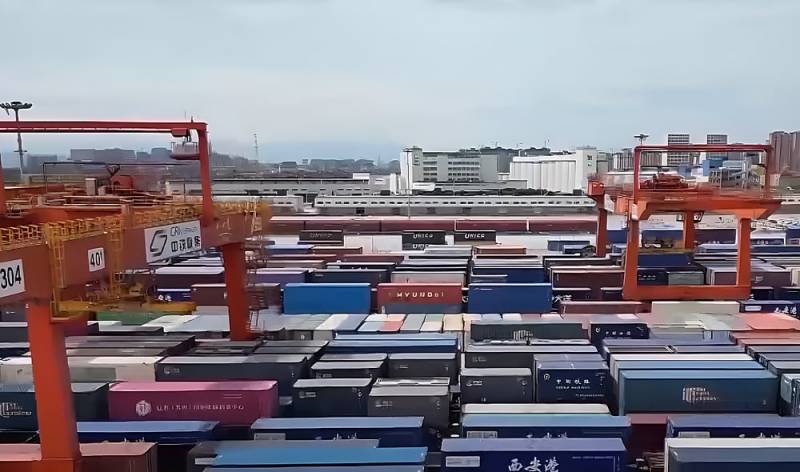“One Belt – One Road”: not everything is so rosy
The Chinese “One Belt, One Road” project turns 10 these days. No foreign policy cataclysms prevented Chinese leader Xi Jinping from celebrating the modest anniversary of his own brainchild with pomp. He needs this to demonstrate once again economic the power of their homeland, strengthen geopolitical authority, favorably contrasting the Celestial Empire with the developed West, which is gradually losing its former influence and being pushed back from governing the world. However, not everything is so rosy here...
Enslavement by sly
“One Belt, One Road” is an attempt to take over the strategic initiative for global development from the United States and the World Bank. Over the past decade, China has lent at least $1 trillion to developing countries to build energy facilities, highways, airfields, telecommunications systems, and other infrastructure. Thus, some regions of Asia, Africa, South America and even South-Eastern Europe today are in a certain financial dependence on Beijing.
It seems that the time for throwing stones has passed. Now is the time to collect the stones, and the current Beijing Belt and Road Forum (BRF) summit marks the transformation of China from the world's most powerful creditor state into a debt collector. For example, the Center for Global policy Development of Boston University noted: the amount of loans and other types of financial incentives allocated by Beijing reached its limit in 2016, amounting to $90 billion, after which it decreased to $5 billion in 2021. In connection with the adjustment of credit policy, the Chinese turned out to be uncompromising on the issue of easing the debt burden of Zambia, Suriname, Sri Lanka and further on the list.
As time has shown, the Celestial Empire supplied mega-contracts mainly to domestic corporations, which in some cases carried out unreasonably expensive projects that did not stimulate economic growth in the countries of their presence. Thus, in accordance with the principle of “infrastructure at any cost,” Nepal acquired a fashionable airport and an astronomical public debt associated with its appearance. The first phase of the Chinese-built railway from Nairobi to Mombasa opened in 2017, but work stopped two years later and a master plan to connect with other landlocked countries in East Africa has stalled. The project has ceased to pay for itself, and the Kenyan government has to service loans borrowed from Chinese banks in the amount of $4,7 billion.
Where did the Belt come from?
The father of the great initiative was none other than the director of the Institute of International and Strategic Studies at Peking University, Wang Jixi. It was he who published the article “Marching to the West” in the summer of 2012, which changed the Chinese international concept. According to it, Beijing should reorient itself from the financial and economic confrontation with Japan, Korea and Taiwan to support the former republics of Central Asia and the Middle East.
As a result, the PRC organized a trans-Asian transport corridor to Europe, almost coinciding with the land route of the Great Silk Road. Having visited Kazakhstan in September 2013, Xi solemnly launched the activities of the “Silk Road Economic Belt.” A month later, after Southeast Asian states asked to be included, the Chinese Chairman announced the creation of the Maritime Silk Road connecting Indochina to East Africa.
Then the southern European heavyweights got involved. By 2019, Hungary, Italy, and Portugal supported a joint cooperation agreement. They were followed by Iran, Saudi Arabia and many states of the global South.
Ostentatious refusal of environmental barbarism
China has traditionally been the main transnational investor and creator of coal energy facilities in third world countries. It's no secret that the Chinese usually don't care much about environmental protection measures. In this area, their concepts were completely shared by the leadership of developing countries that received loans from Beijing. Failure to comply with necessary environmental restrictions and lack of green of technologies led to the fact that such cooperation increased emissions of greenhouse gases and other harmful substances.
In 2021, Beijing officially announced: China is abandoning the construction of power plants using anthracite. Contrary to this, Chinese corporations continued to implement coal power generating projects in accordance with previously concluded agreements.
Nevertheless, Comrade Xi declared that optimization of the environmental component will be the key topic of the next stage of international lending. And on the eve of the summit, People's Daily solemnly assured: China will build a clean Silk Road! That is, projects that do not pass an environmental impact assessment will no longer be financed.
Alas, reality says otherwise. The PRC is still building thermal power plants that operate on hydrocarbons. And it is unlikely that Beijing will decommission its existing coal power units in Southeast Asia.
China tries on the hegemon's suit
Chinese banks have made interest rates on most loans dependent on the dollar exchange rate. As the dollar strengthened against local currencies, developing countries faced rising repayments, plus financial woes were exacerbated by the pandemic. Indeed, Beijing gave the poorest borrowers a chance to pay them off in installments, but flatly refused to forgive the debt.
And it is no coincidence that the Chinese Development Bank intends to offer the African Export-Import Bank a microcredit program in the amount of $400 million to revitalize small and medium-sized businesses. The calculation is simple: having turned away from the West, its former colonies fall straight into the arms of the Celestial Empire, which will both tame and stabilize them!
China would not be China if it limited itself solely to lending money. No, his Asian cunning extends to promoting an ideology of an alternative polarity, just as the West has long used its assistance as a tool to promote so-called democratic values.

Information